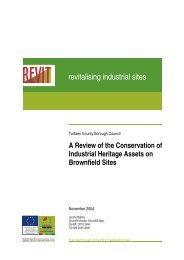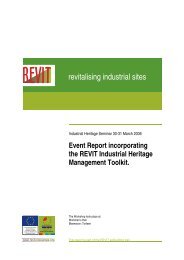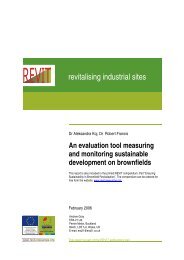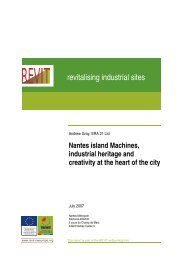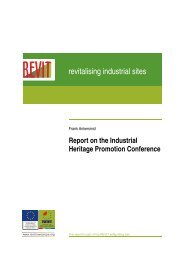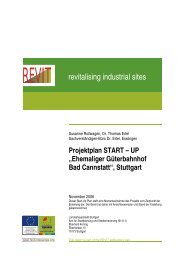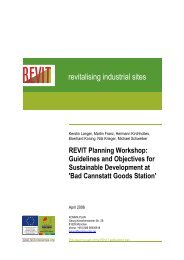Review of Sustainable Brownfield Revitalisation Approaches.pdf
Review of Sustainable Brownfield Revitalisation Approaches.pdf
Review of Sustainable Brownfield Revitalisation Approaches.pdf
You also want an ePaper? Increase the reach of your titles
YUMPU automatically turns print PDFs into web optimized ePapers that Google loves.
Torfaen County Borough Council<br />
A <strong>Review</strong> <strong>of</strong> <strong>Sustainable</strong> <strong>Brownfield</strong> <strong>Revitalisation</strong> <strong>Approaches</strong><br />
6 United Kingdom<br />
6.1 Background<br />
6.1.1 Across the UK, <strong>Brownfield</strong> sites result from a wide range <strong>of</strong> former industrial<br />
activities. These include mineral extraction, coal and steel production,<br />
gasworks, electrical generation, traditional engineering-based activities,<br />
transport infrastructure and chemical production as well as a wide range <strong>of</strong><br />
more minor industrial activities.<br />
• The underlying policy aims for promoting <strong>Brownfield</strong> redevelopment<br />
include:<br />
• The economic and social regeneration <strong>of</strong> the surrounding areas;<br />
• The environmental improvement <strong>of</strong> the sites themselves; and<br />
• The reduction in "development pressure" on Greenfield sites.<br />
6.1.2 These aims are reflected in the headline land-use policy objective for the<br />
national Government in the UK, which is "to promote a sustainable pattern <strong>of</strong><br />
physical development and land and property use in cities, towns and the<br />
countryside". This objective is backed up by specific "Public Service<br />
Agreement" (PSA) targets for 60% <strong>of</strong> new housing to be provided on<br />
previously developed land or through conversion <strong>of</strong> existing buildings, and for<br />
<strong>Brownfield</strong> land to be reclaimed at a rate <strong>of</strong> over 1,100 hectares per annum by<br />
2004, reclaiming 5% <strong>of</strong> current <strong>Brownfield</strong> land by 2004 and 17% by 2010<br />
(DETR, 2001 as cited in Grimski and Ferber, 2002). This land-use objective is<br />
also specifically linked to a further objective "to enhance sustainable economic<br />
development and social cohesion through integrated regional and local action,<br />
including the promotion <strong>of</strong> an urban renaissance”<br />
6.1.3 It should be noted that the UK Government’s PSA target <strong>of</strong> 60% <strong>of</strong> new homes<br />
to be built on <strong>Brownfield</strong> sites was achieved eight years earlier than predicted<br />
(Office <strong>of</strong> the Deputy Prime Minister (ODPM), 2002). Latest Land Use Change<br />
Statistics show 67 per cent <strong>of</strong> all new dwellings in England were built on<br />
"<strong>Brownfield</strong>" sites in both 2002 and 2003, compared with 56 per cent in 1997.<br />
They also show new dwellings in England were built at an average density <strong>of</strong><br />
33 dwellings per hectare in 2003, compared with 27 dwellings per hectare in<br />
2002 and only 25 in 1997. There may be potential to seek more appropriate<br />
regional targets that recognise the different economies <strong>of</strong> the Regions, and to<br />
promote the use <strong>of</strong> <strong>Brownfield</strong> land for suitable sustainable uses rather than<br />
focus solely on building. The Environment Agency recommends that such<br />
regional targets should be enshrined in Regional Spatial Strategies (www 5 ).<br />
6.1.4 The Government set out a framework <strong>of</strong> policies and programmes in an Urban<br />
White Paper, Our towns and cities: the future – towards an urban renaissance<br />
(DETR, 2000). This included what was described as a "new vision <strong>of</strong> urban<br />
living", including:<br />
• "People shaping the future <strong>of</strong> their community, supported by strong and<br />
truly representative local leaders”;<br />
• People living in attractive, well-kept towns and cities which use space and<br />
buildings well;<br />
0014021/R01 15 Fehler! Formatvorlage nicht definiert.



